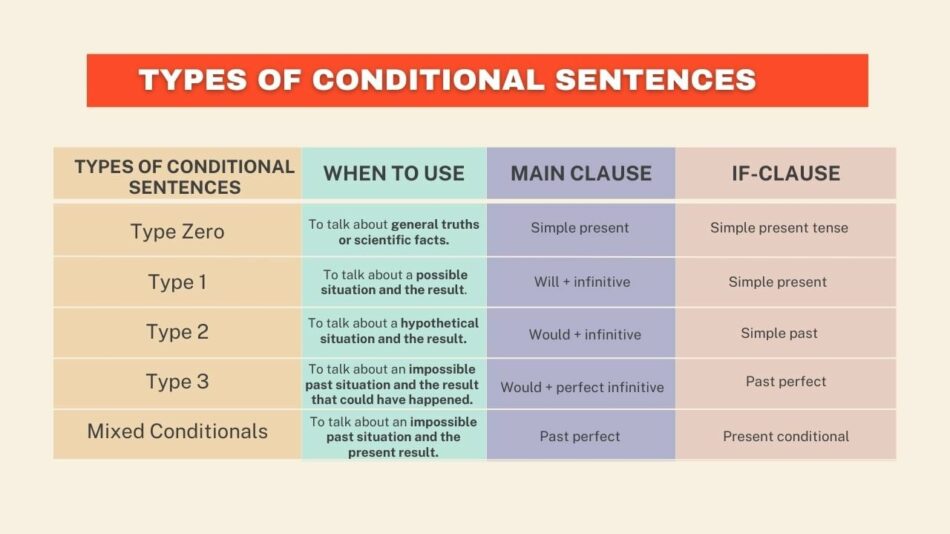Conditional sentences, commonly referred to as “if sentences,” are a crucial part of the English language. They allow speakers to express situations that depend on specific conditions. Understanding the structure and nuances of these sentences can greatly enhance your command of English. In this article, we will delve into the four types of conditional sentences, elucidating their distinct structures and uses, thereby equipping you with the essential knowledge needed to master this aspect of the language.
Conditional sentences are generally classified into four categories: zero conditional, first conditional, second conditional, and third conditional. Each type serves a unique purpose and employs different grammatical structures. Let’s explore these types in detail:
-
Zero Conditional
The zero conditional is used to express general truths, scientific facts, or situations that are always true when the condition is met. This type of conditional sentence employs the simple present tense in both the if-clause and the main clause.
Struktur: If + simple present, simple present.
Contoh: If you heat water to 100 degrees Celsius, it boils.
In this example, the statement describes a scientific fact. Whenever the condition (heating water to 100 degrees Celsius) is fulfilled, the result (water boiling) occurs universally. Therefore, the zero conditional conveys a sense of certainty and is often used in discussions surrounding scientific laws, rules, or habits.
-
First Conditional
The first conditional is employed to discuss real or possible situations in the future. It is often used for predictions based on present circumstances or likely outcomes. The structure of the first conditional incorporates the simple present tense in the if-clause and the simple future tense in the main clause.
Struktur: If + simple present, will + base form of the verb.
Contoh: If it rains tomorrow, I will stay at home.
Here, the speaker considers a potential future event (raining tomorrow) and states the likely outcome (staying at home) if the condition is met. The first conditional provides a pragmatic approach to discussing future scenarios, making it highly practical in everyday conversations, particularly in planning or forecasting.
-
Second Conditional
The second conditional pertains to hypothetical or unreal situations in the present or future. It is often used to express dreams, wishes, or scenarios that are unlikely to happen. The structure consists of the simple past tense in the if-clause and the conditional mood (would + base form of the verb) in the main clause.
Struktur: If + simple past, would + base form of the verb.
Contoh: If I had a million dollars, I would travel the world.
This example illustrates a scenario that is unlikely, as it is not a realistic assumption for the speaker. The second conditional allows speakers to discuss imaginative situations or aspirations that lack grounding in reality, making it a vital component of expressive language.
-
Third Conditional
The third conditional is used to reflect on past situations that did not occur and their hypothetical outcomes. This type emphasizes regret, reflection, or lessons learned from past events. The structure involves the past perfect tense in the if-clause and the modal “would have” plus the past participle in the main clause.
Struktur: If + past perfect, would have + past participle.
Contoh: If I had known about the meeting, I would have attended.
This sentence conveys a regretful thought about a past scenario that did not happen, emphasizing the missed opportunity. The third conditional often serves as a powerful tool for expressing feelings of regret, nostalgia, or reflection, allowing speakers to analyze how different choices could have led to various outcomes.
Understanding the four types of conditional sentences is fundamental for anyone looking to master English grammar. Each type serves a distinct function, allowing speakers to convey different meanings and scenarios effectively. The zero conditional helps articulate universal truths; the first conditional discusses real future possibilities; the second conditional delves into hypothetical situations; and the third conditional reflects on unrealized past events.
As you incorporate these conditional structures into your writing and speech, consider the context in which you are communicating. Mastering the nuances of each conditional type will enhance your ability to express complex ideas and adapt your language to various scenarios. By remaining cognizant of the conditions and their results, you will not only improve your grammatical proficiency but also enrich your overall communication skills in English.
In conclusion, the mastery of conditional sentences serves as a significant stepping stone in understanding the English language. As you practice forming and utilizing these sentences in different contexts, your confidence in discussing conditions and their consequences will undoubtedly grow. Embrace this knowledge as part of your journey toward fluency, and watch as your ability to articulate thoughts and ideas flourishes.










